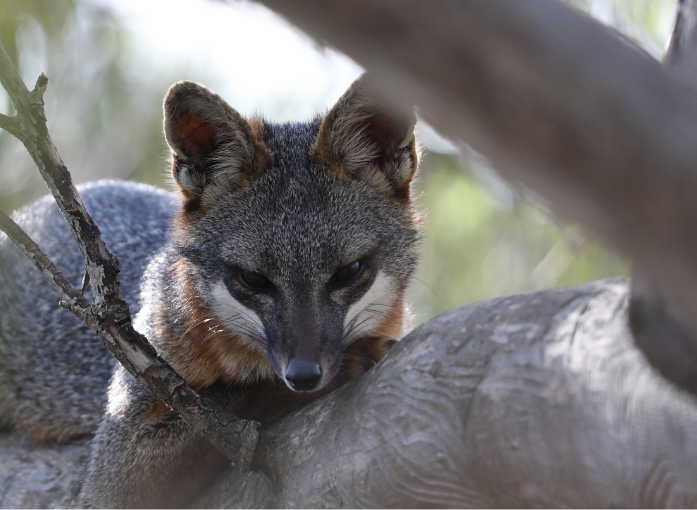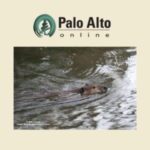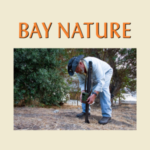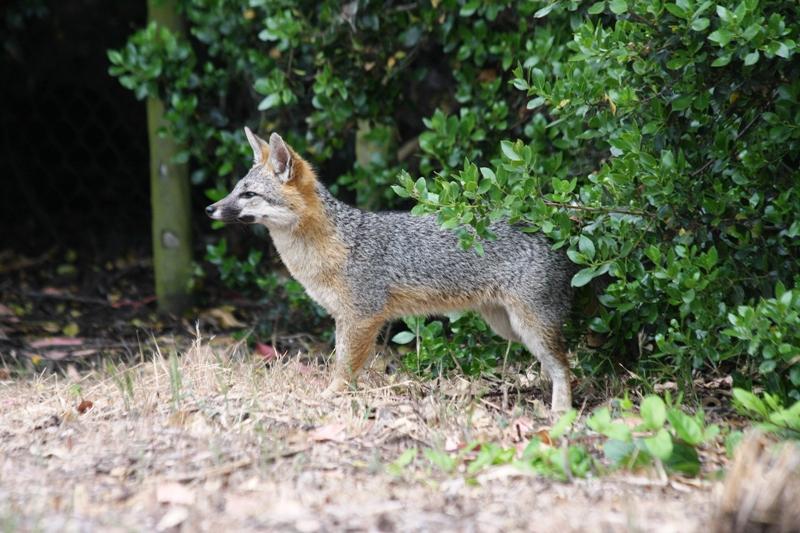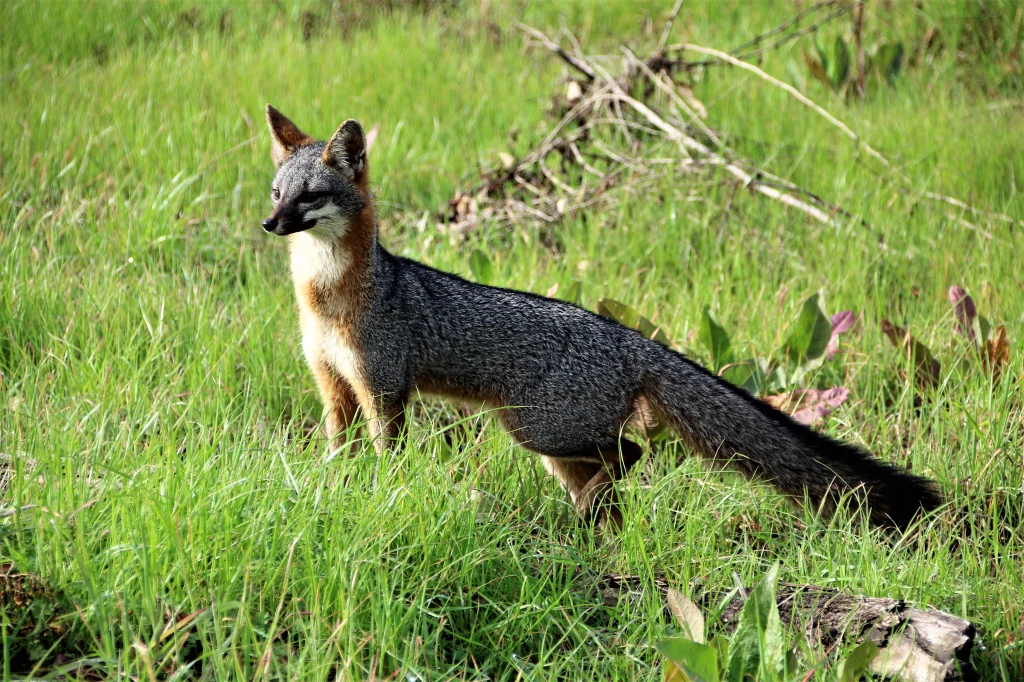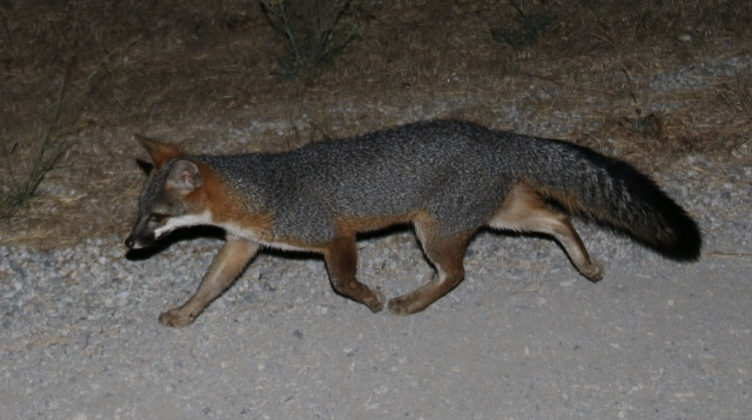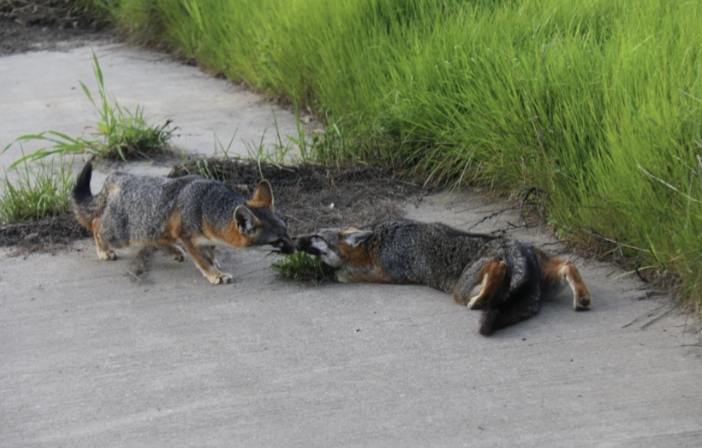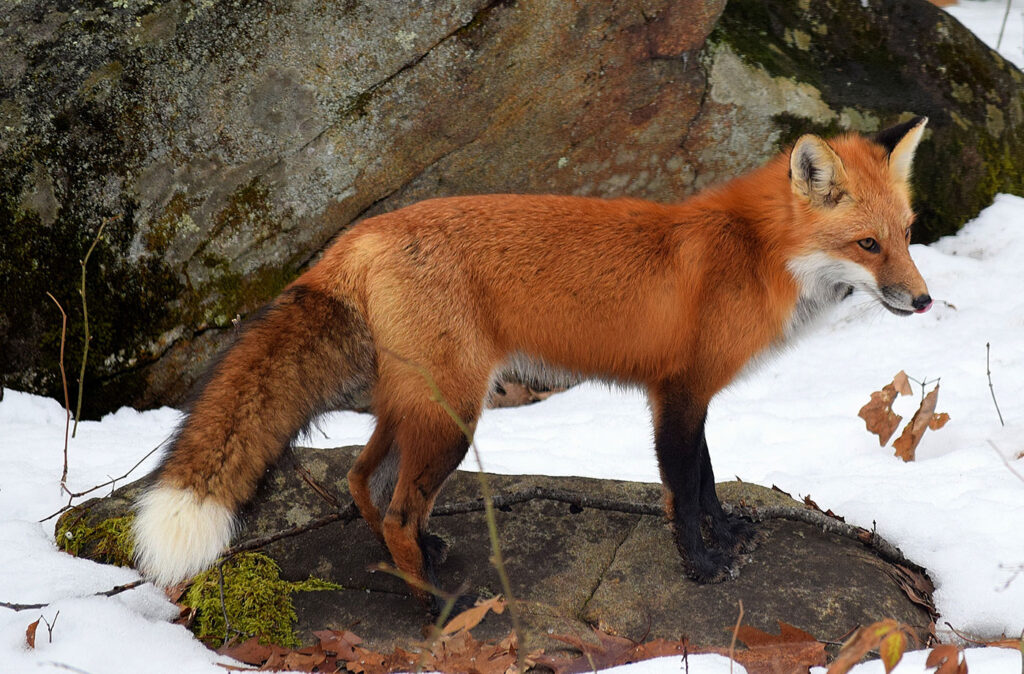by William C. Leikam
President, CEO & Co-founder, Urban Wildlife Research Project
What I’ve Learned About Gray Fox Behavior
Part 4 – What Do Foxes Do with Prey – Caching Food
Last month I wrote about Food and the Origins of the Gray Fox Hierarchy. Let’s explore gray foxes and their food a bit deeper. Once the gray foxes Mama Bold and her mate Gray became rather comfortable with me being in their vicinity, they simply went about their every day lives with me hanging out in the background observing and taking notes on what I saw. That’s not to say that they didn’t have limits on how close they’d allow me to come. They maintained about a ten-foot comfort zone. For the most part they were casual and tolerant of me, but if a second person came with me, their skittishness clearly showed. Their normal ten feet distance suddenly became 50 or more feet away.
Strange Cache
So, it was that I watched them take down wood rats, field mice, young geese, ducks, ground squirrels, and sometimes a tree squirrel for as we know, these gray foxes are adept at climbing trees. One morning in mid-May, I walked up onto Fox Hollow Hill and followed the trail back toward one of my trail cameras. I hadn’t walked far when ahead I saw the male fox Gray pawing the ground. He concentrated on digging. I silently watched.
Once he had pushed away enough dirt, he put his muzzle into the shallow hole and pulled out the remains of prey that he had caught and cached. I couldn’t tell what kind of an animal it was, but it was on the larger size of prey in the baylands, possibly the remains of a jack rabbit. That was the first time that I knew that these foxes cached their food. I watched and as Gray tore at the flesh, I noticed a gelatinous substance covering the meat. I cannot be 100% certain of that, because as Gray ate, he often moved and blocked my view, but I am better than 50% sure that, that’s what I saw.
Over the years, I have not had any live opportunities to see a gray fox eating from its cache as Gray did, and over the years I’ve pondered how it could be that if I saw what I think I saw, there was that jelly-like covering over the meat. Conclusion? It must have something to do with an enzyme in a gray fox’s saliva.
Teaching Her Pups
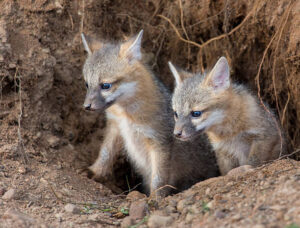 One night one of the trail cameras picked up a scene that I will never forget. Mama Bold was out with her month-old pups. The family had recently moved to a new location, a part of which was up on Fox Hollow Hill right where I had located one of the trail cameras. In the dark of the night, Mama Bold led her four pups to a pile of leaves and brush that had been cut and piled up there years before. Mama briefly dug and pulled out a cached prey. I couldn’t tell what it was, but the pups knew that it was food and they pounced on it. Mama Bold walked to the left side of the pile of brush and pulled out another prey. In that one teaching-moment her pups knew about the cache, how to retrieve food, and now they knew where to get a meal if Mama Bold or Papa Gray didn’t bring home a rodent or other such prey the night before.
One night one of the trail cameras picked up a scene that I will never forget. Mama Bold was out with her month-old pups. The family had recently moved to a new location, a part of which was up on Fox Hollow Hill right where I had located one of the trail cameras. In the dark of the night, Mama Bold led her four pups to a pile of leaves and brush that had been cut and piled up there years before. Mama briefly dug and pulled out a cached prey. I couldn’t tell what it was, but the pups knew that it was food and they pounced on it. Mama Bold walked to the left side of the pile of brush and pulled out another prey. In that one teaching-moment her pups knew about the cache, how to retrieve food, and now they knew where to get a meal if Mama Bold or Papa Gray didn’t bring home a rodent or other such prey the night before.
A Funny Story
On another occasion I stood at the edge of a large sand filter. It was a rectangle measuring about 25 feet by around 50 feet. When gray foxes cache their food, they always mark it with either feces or urine. That’s to let all others know who “owns” that cache, and remember from a previous report that gray foxes absolutely do not share.
A mated pair of gray foxes emerged from the brush off to my left at about 25 feet or so. These foxes knew me and so they were not skittish. The male of the pair had a rodent in its mouth. He looked around and across the filter that stretched for some 50 feet in length, then trotted over to the far side, dug a hole in the sandy-soft earth, covered it with his nose and he trotted off to my right. Almost immediately, his mate who watched all that, trotted over to where he had buried his cache, uncovered it, and dashed off into the brush. I stood there rather surprised. The male had forgotten to mark his cache. That taught me that until the cache is marked, the prey is up-for-grabs and that’s exactly what his mate did. She “stole” her mate’s cache and likely buried it back in the brush and marked it as her own.
Grey Fox General Health
There are no gray foxes in the Palo Alto Baylands Nature Preserve. However, there is a family of three red foxes that have moved into the territory. Presently, we are monitoring them.
Gray Fox, Baylands Goals
Within the permit that allows the Urban Wildlife Research Project to conduct its study of the behavior of the gray fox at the Palo Alto Baylands Nature Preserve, the objectives covered are:
- Monitoring of urban gray fox Denning sites in Palo Alto Baylands.
This is being accomplished during the period when the gray foxes use a den site. It is one of the prime locations for gathering most of the behavioral data of the litter and for adults alike.
- Assessment of status and population trends of Baylands urban gray foxes.
Since January 2019 a pair of resident gray foxes have claimed territory at the Palo Alto Baylands Nature Preserve.
- Identification of habitat features that promote the presence of urban gray foxes.
The Urban Wildlife Research Project is working on a project to remove the concrete from Matadero Creek that will create linkages and corridors between the Santa Cruz Mountain Range and the Palo Alto baylands..
- Assessment of reproductive success and identification of factors that promote successful reproduction.
Open the pinch-point along Matadero Creek by developing thickets that link one area to another, instead of the present island-like habitat.
- Identification and assessment of possible dispersal travel routes.
Dispersal routes move between the Palo Alto Baylands Nature Preserve and the Shoreline region over in Mountain View. In a north-westerly direction the dispersal corridors run just behind the homes bordering the marshlands.
What's Happening at UWRP?
On Wednesday, May 7th 2025, Bill was interviewed by Alie Ward for her podcast called Ologies. Time Magazine rated Ologies as one of the Nation’s top 50 podcasts. We will post a link here once the interview is posted.
On June 14, in the Elephant Room at Safari West, 7:00 PM, Bill will give a talk on the behavior of the gray foxes that he has studied over this past 15 years.
Be on the lookout for Bill being booked to give another talk over at Meta (Facebook). We’re working on it.
The Urban Wildlife Research Project will be present at Safari West for Earth Day on April 26th. Why not drop by our booth and say hello.
If you or your organization would like to have Bill aka the Fox Guy present one of his four PowerPoint presentations:
1. A Year with the Urban Gray Fox – MOST POPULAR
2. Human Development, Sixth Mass Extinction & Gray Foxes – An historical look at how we got to our present place in history.
3. Gray Fox Cognition – What & How Gray Foxes Perceive – This is an attempt to get inside the mind of a gray fox
4. Corridors & Connections – Sustaining the Health of Our Wildlife – The title says it all
Contact us here https://urbanwildliferesearchproject.org/contact/ and let us know.
Videos and Documentaries

My journey to the University of Zurich, Switzerland, Triggered By Motion

Bill’s book The Road to Fox Hollow can be purchased directly from Bill for a mere $20.00. Just email him through the Contact form on the Urban Wildlife Research Project’s website, leave your email address and he will get back to you. Or you can contact the publisher Di Angelo Publications .
A video documentary about Bill’s work with the foxes and produced at Stanford University by Syler Peralta-Ramos.
What happens when an opossum and a red fox meet in the night?
In contrast to two other raccoon discipline videos, this one is rather mild.
Gray Fox Playfulness “Hugging” Behaviors.
See the violence of Discipline Raccoon Style.
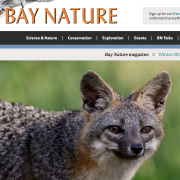
“How to be a Fox” The article about Bill and his ethological approach to his study of the gray fox is online here. Many are calling this a major article in the wildlife press.
Be Sure to check out our YouTube Channel for some incredible wildlife videos.

